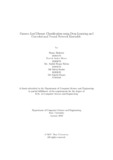Cassava leaf disease classification using deep learning and convolutional neural network ensemble
Date
2022-01Publisher
Brac UniversityAuthor
Shahriar, HasanShuvo, Protick Sarker
Fahim, Md. Saidul Haque
Sordar, Md Sobuj
Haque, Md Esadul
Metadata
Show full item recordAbstract
Cassava is a high-protein and nutrient-dense plant, notably inside the leaves. Cassava
is often used as a rice alternative. Pests, viruses, bacteria, and fungus may cause
a variety of illnesses on cassava leaves. This study consists of four main diseases that
commonly affect cassava leaves: Cassava Bacterial Blight (CBB), Cassava Brown
Streak Disease (CBSD), Cassava Green Mite (CGM), and Cassava Mosaic Disease
(CMD) and we took these four diseases as labels in our research. Furthermore, we
took 22000 infected images from Kaggle and we have transformed our dataset into
four different image transformation to ensure the accuracy of our model. These
four different augmentations are Random Crop Augmentation, Random Flip Augmentation,
Random Rotation Augmentation and Random Contrast Augmentation.
Finally, we used six algorithms to detect the diseases of cassava leaves. These six algorithms
are Xception, EfficientNetB0 Resnet50, VGG16 Densenet121, InceptionV3.
While we operated these algorithms on our trained dataset, it gave diverse precision.
For the Xception, it gave 91.3% accuracy, EfficientNetB0:91.1%, ResNet50: 85.0 %,
VGG16: 68.0 %, DenseNet121: 87.0 % and for the InceptionV3, it gave 86.4 % precision
respectively. Here, not every one of the algorithms performed well. Xception
and EfficientNetB0 have the most noteworthy accuracy among these.

